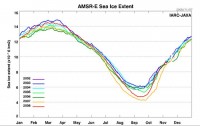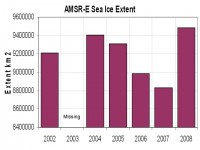i>Investor’s Business Daily
From California to Missouri, four of five environmental initiatives lost at the ballot box. Voters are clearly still not ready for exorbitant costs and excessive regulation without clear benefits. President-elect Obama may have felt “a righteous wind” at his back during the campaign, but it did not translate into environmental victories at the ballot box, where one green initiative after another failed for a variety of reasons.
California voters shot down both clean-energy propositions on the ballot. Proposition 7 would have required utilities to generate 40% of their power from renewable energy by 2020 and 50% by 2025. It lost 65% to 35%. Proposition 10 would have created $5 billion in general obligation bonds to help consumers and others purchase certain high-fuel-economy or alternative-fuel vehicles, and to fund research into alternative fuel technology. It failed 60% to 40%. Even in San Francisco, the capital of liberalism and greenie fervor, voters rejected Proposition H, which would have mandated a rapid increase in the city’s use of clean energy to achieve its goal of being 100% renewable by 2040. It would also have meant taking over the city’s private electric company.
Obama took the former red state of Colorado, which also elected environmentalist Senate candidate Mark Udall over oil executive Bob Shaffer. Yet Coloradans struck down a measure to pay for conservation and clean energy by increasing taxes on oil companies. Only in Missouri did green energy score a victory. There, Proposition C mandated a 15% increase in renewable energy by 2021 with slow and steady yearly increases that energy companies felt they could phase in without disruption and with which voters felt more comfortable.
The mantra is that oil and car companies are blocking the increased use of renewable energy. The truth is that consumers, through their choices and their votes, are slowing the stampede. They worry about the cost in tough economic times and whether such efforts are worth it based on dubious evidence of global warming. Energy independence is one thing, but going bankrupt to achieve it is quite another.
When gasoline prices were over $4 a gallon, the chant “drill baby drill” grew loud enough that Democrats were forced to back off renewing a ban on offshore drilling. Now in complete control, they can block offshore drilling, nuclear power and shale oil in their Ahab-like pursuit of alternative energy. Texas consumers are finding out how expensive the pursuit of alternative energy can be. Their state generates more electricity from wind than any other, and people like oil legend T. Boone Pickens want to generate more. A just published study by the Texas Public Policy Foundation, “Texas Wind Energy: Past, Present and Future,” says that to achieve even modest amounts of wind energy would cost rate payers and taxpayers at least $60 billion through 2025. That includes transmission costs, production costs, subsidies, tax breaks, economic disruption costs and grid-management costs. Because of the intermittent nature of wind, the Electric Reliability Council of Texas uses a figure of only 8.7% of wind power’s installed capacity when determining available power during peak periods.
On cloudy and windless days, solar and wind are useless and require conventional power sources as backup. Output is not steady and cannot be increased on demand. You can’t make the sun shine brighter or the wind blow harder during peak periods. A Feb. 27 Reuters story illustrated the point. Headlined “Loss Of Wind Causes Texas Power Grid Emergency,” it told of an electric grid operator forced to curtail 1,100 megawatts of power to customers on just 10 minutes’ notice. The wind simply stopped blowing.
Wind turbines generally operate at only 20% efficiency compared with 85% for coal, gas and nuclear plants. A single 1,000-megawatt nuclear power plant would generate more dependable power than 2,800 1.5-megawatt, occasionally operating wind turbines sitting on 175,000 acres. Nuclear power is clean energy, and you wouldn’t have to wait for a sunny or windy day to plug in your electric car.
Read more here.
Joe D’Aleo, AMS Fellow
The latest daily arctic sea ice extent chart from IJIS shows the current year ice extent at the highest level in the record back to 2002. (2003 was missing).
 See larger image here
See larger image here
The daily extents on November 7 look like this:

See larger image here
This represents an increase of 655,781 square kilometers over last November 7 or 7.4%. Side-by-side images from the Cryosphere show there is more ice on both the Pacific and Atlantic side this year. This is 44 days before the start of the Northern Hemisphere winter and 5 months before it will peak.

See larger image here
See pdf here.
By Kenneth P. Green
It would indeed create jobs, but it would do so by killing other jobs. Is that really what Americans want?
President-elect Barack Obama has put energy policy at the forefront of his agenda. He says that his plan will boost our national security, help us achieve “energy independence,” reduce greenhouse gas emissions, and promote job creation. Indeed, Obama vows to create around five million new jobs by increasing federal spending on renewable energy sources such as wind, solar, and biofuels.
As many experts have observed, the science behind the Obama plan is dubious, particularly when it comes to ethanol. The renewable energy industry simply does not have the capacity (at least not yet) to power large swathes of our fossil fuel-driven economy. Just look at the United Kingdom, where a shortage of windmill-building capability has hindered the government’s plan to replace aging nuclear reactors with wind power.
If Obama’s energy promises rely on questionable science, they rely on even more questionable economics. We are to believe that replacing conventional energy sources (especially coal) with renewables (especially wind) will create five million new “green jobs.” The hope is that armies of workers will be enlisted to build tens of thousands of windmills; to manufacture and deploy solar-power installations; to harvest, transport, and process huge amounts of biofuel feedstock; and to string the power lines that will allow the U.S. power grid to incorporate a major expansion of intermittent energy.
Unfortunately, the idea of government “job creation” is a classic example of the broken window fallacy, which was explained by French economist Frederic Bastiat way back in 1850. Read more about this here.
The Obama plan reflects fallacious thinking of the first order. There may be sound reasons to switch from existing energy sources to renewables, including the need to slash greenhouse gas emissions, the need to reduce our dependence on Middle Eastern oil, and the need to meet growing energy demand. If Americans wish to pay for a wholesale transformation of the energy industry, that is their choice. But let’s not lie about the costs, and let’s not espouse an economic fallacy that is nearly 160 years old. Obama’s “green jobs” plan would indeed create jobs, but it would do so by killing other jobs. Is that really the type of energy policy Americans want?


